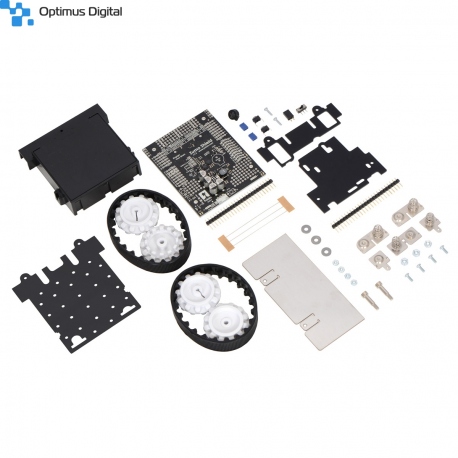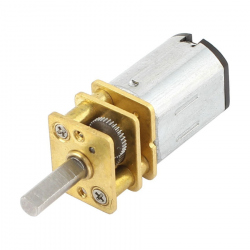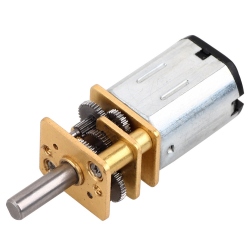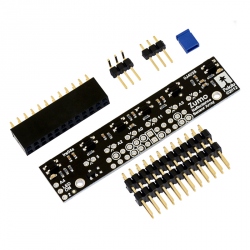Dupa plasarea solicitării de comandă, in sectiunea Istoric puteti vedea cate solicitări de comandă mai avem de procesat inaintea dumneavoastra
Program de lucru: Luni - Vineri 9:00 - 18:00, pauza 13:00 - 14:00.
Se efectueaza lucrari de mentenanta la site si pot aparea erori. In cazul in care intampinati erori va rugam sa reincercati mai tarziu.
Ridicarea personala este disponibila pentru comenzile achitate in avans. Se pot ridica dupa ce sunt pregatite.
No products
 View larger
View larger
Robot Chassis Kit for Arduino Zumo v1.2 (Without Motors)
0104110000010155
New product
Robot Chassis Kit for Arduino Zumo v1.2 (Without Motors)
See description for more details about the product.
Add to cart now!
This product is no longer in stock
- Write a review
- Remove this product from my favorite's list.
- Add this product to my list of favorites.
More info
Descriptions
Kit Contents
- One Zumo Shield for Arduino, v1.2
- One Zumo chassis kit
- One Zumo blade
 Contents of the Zumo robot kit for Arduino, v1.2.
Contents of the Zumo robot kit for Arduino, v1.2.Please see the specific pages for those products for more information about them, assembly instructions, and links to related resources. The only difference between this and the previous Zumo Robot kit version is the inclusion of a v1.2 Zumo shield in place of the previous shield version. The only changes to the shield are an upgrade of the integrated accelerometer/magnetometer IC and the addition of a 3-axis gyroscope.
 Zumo Robot for Arduino, v1.2.
Zumo Robot for Arduino, v1.2. Zumo chassis being assembled with two micro metal gearmotors.
Zumo chassis being assembled with two micro metal gearmotors.
Required Accessories (not included)
- Two micro metal gearmotors. These gearmotors are available in several power options and a wide variety of gear ratios, allowing for a customizable combination of torque and speed. The Zumo Shield can deliver enough power for all of the micro metal gearmotors we carry, including the high-power (HP) versions. Note that some gear ratios are better suited for the Zumo than others; please see the Zumo chassis kit product page for specific motor suggestions.
- Four AA batteries. The Zumo chassis works with both alkaline and NiMH batteries, though we recommend rechargeable NiMH cells.
- An Arduino or compatible control board. The Zumo Shield works with the A-Star 32U4 Prime, Arduino Uno and Arduino Leonardo. It is not compatible with the Arduino Mega or Due, but it can be used with older Arduinos that have the same form factor as the Uno, such as the Duemilanove. (Other Arduino-compatible controllers might work with the Zumo robot, but support for them will be limited and they might require modification; for example, one customer got his Zumo robot working with the Freescale FRDM-KL25Z board.)
 Zumo chassis being assembled with two micro metal gearmotors.
Zumo chassis being assembled with two micro metal gearmotors.
Optional Accessories(not included)
- Zumo reflectance sensor array. This sensor bar mounts along the front edge of the Zumo shield and allows the Zumo to detect features on the ground in front of it, such as lines for following or edges for avoiding (such as the rim of a sumo ring or the edge of a table). It is designed specifically for use with the Zumo shield.
- iMAX-B6AC battery charger for charging the Zumo’s battery’s through the Zumo Shield’s 2-pin charge port. Note that you only need a battery charger if you plan on powering the Zumo with rechargeable cells, and that charger should be capable of charging 4 NiMH cells in series. Alternatively, since the Zumo just uses ordinary AA batteries, you can use AA chargers (into which you stick the individual cells) available at most general electronics stores.
- Optical rangefinders for obstacle/opponent detection.
- Connectors (headers, jumper wires, etc) for adding more sensors.
- Replacement sprockets in red or white. The Zumo robot for Arduino includes the black sprockets shown in the left picture below, but other colors can be purchased separately if you want to add a bit of personalization to your robot. The following pictures show the newer Zumo 32U4 Robot, which is based on the same Zumo chassis and therefore uses the same sprockets:
 Zumo 32U4 robot with black sprockets.
Zumo 32U4 robot with black sprockets. Zumo 32U4 robot with black sprockets.
Zumo 32U4 robot with black sprockets. Zumo 32U4 robot with black sprockets.
Zumo 32U4 robot with black sprockets.
Comparison with the Zumo 32U4 robot
The newer Zumo 32U4 is another robot based on the Zumo chassis. It is a more highly integrated robot than the Zumo robot for Arduino, with enhancements that include a built-in Arduino-compatible ATmega32U4 microcontroller (the same one used in the Arduino Leonardo and A-Star 32U4 boards), an LCD, encoders for closed-loop motor control, and proximity sensors for obstacle detection. The Zumo 32U4 main board effectively combines the functions of the Zumo Shield and the separate Arduino controller into a single, compact board that is just as easy to program as a standard Arduino or A-Star thanks to its USB interface and preloaded Arduino-compatible bootloader.
 A Zumo 32U4 robot (left) and a Zumo robot for Arduino with an A-Star 32U4 Prime LV (right).
A Zumo 32U4 robot (left) and a Zumo robot for Arduino with an A-Star 32U4 Prime LV (right).Some of the pin mappings and software libraries differ between the Zumo 32U4 and Zumo robot for Arduino, so programs written for one robot generally need to be modified to work on the other.
Don't delay. Buy today.
Add to cart now!
Reviews
Accessories
Customers who bought this product also bought:
-

GA12-N20...
This small and light, yet powerful geared motor...
24,99 lei
-

JA12-N20...
Building a robot goes handy when using this...
44,89 lei






